The last post was mainly about our pullers and pushers. We have one type of puller left to talk about, the John Deere tractor, we have two of these.
 |
| John Deere Tractor |
These have a special adaptation for Antarctica, with a Soucy track in place of each wheel. The John Deeres are very versatile, they can tow nearly as much as a Challenger, they can work in temperatures nearly as cold as a dozer, and they also can lift loads with their front forks.
Because we have so many loads to lift associated with the build of Halley VI and the demolition of Halley V, for the duration of the project we also have a JCB forklift, also with a track conversion.
 |
| JCB forklift |
The JCB will be sent out at the end of the build/demolition, probably next year. Our biggest crane the Mantis will also be sent out at the same time.
 |
| Mantis Crane |
The Mantis is our heaviest vehicle on the iceshelf - it weighs 24 tonnes and can lift 30 tonne loads. Once the Mantis has been sent out, we will still have two Nodwell cranes, capable of 5 tonne lifts.
 |
| Nodwell Crane |
Although the Nodwells are far smaller cranes, they are far better at moving around on the snow. The other vehicle we have is the excavator, this is great for digging snow but the bucket can also be used for lifting small loads for which it is very quick.
How many times did you see Penny?



































